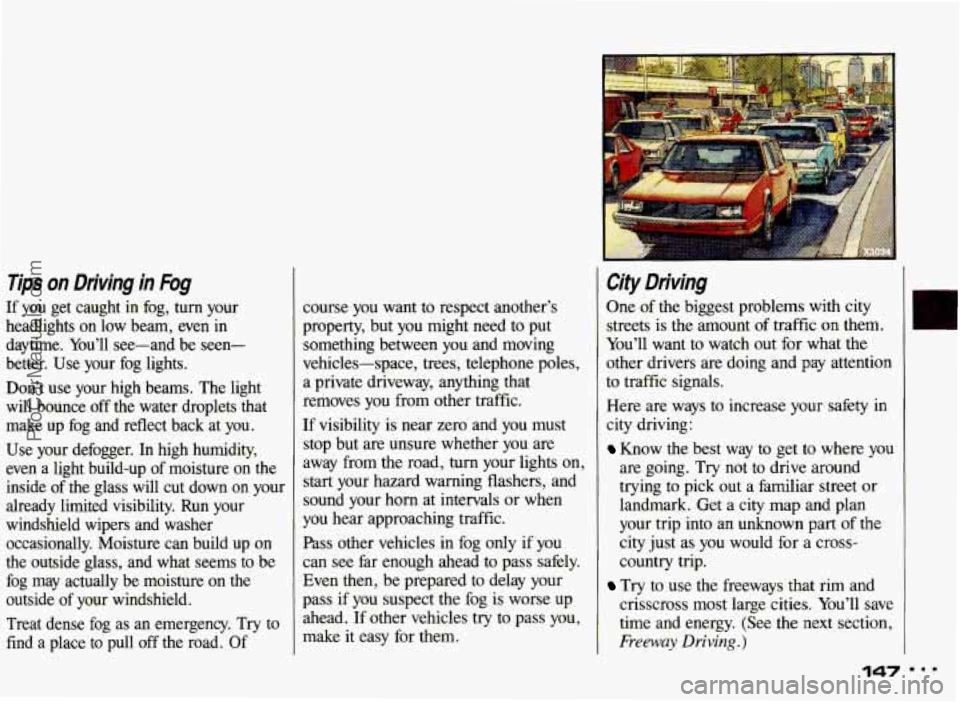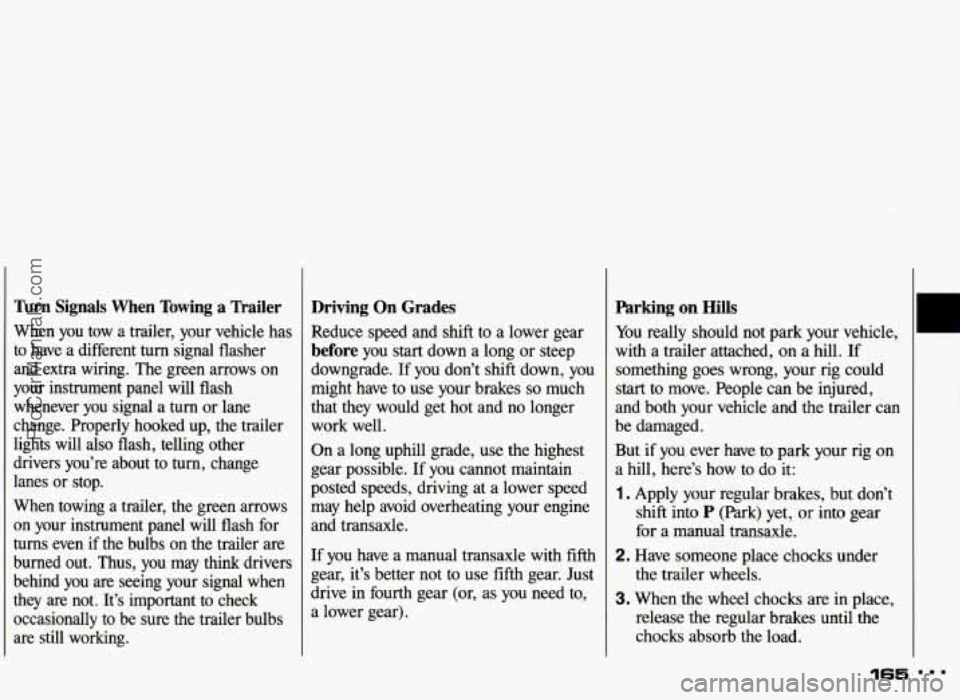1993 PONTIAC GRAND-AM stop start
[x] Cancel search: stop startPage 148 of 306

Tips on Driving in Fbg
If you get caught in fog, turn your
headlights on low beam, even in
daytime, You’ll see-and be seen-
better. Use your fog lights.
Don’t use your high beams. The light
will bounce
off the water droplets that
make up fog and reflect back at you.
Use your defogger.
In high humidity,
even a light build-up of moisture
on the
inside of the glass will cut down
on your
already limited visibility.
Run your
windshield wipers and washer occasionally. Moisture can build up on
the outside glass, and what seems to be fog may actually be moisture on the
outside of your windshield.
Treat dense fog as
an emergency. Try to
find a place to pull off the road. Of course
you want to respect another’s
property, but you might need to put something between you and moving
vehicles-space, trees, telephone poles,
a private driveway, anything that
removes you from other traffic.
If visibility is near zero and you must
stop but are unsure whether you are
away from the road,
turn your lights on,
start your hazard warning flashers, and
sound your horn at intervals or when
you hear approaching traffic.
Pass other vehicles in fog only if you
can see far enough ahead to pass safely.
Even then, be prepared to delay your
pass if you suspect the fog is worse
up
ahead. If other vehicles try to pass you,
make it easy for them.
City Driving
One of the biggest problems with city
streets is the amount of traffic on them.
You’ll want to watch out for what the
other drivers are doing and pay attention
to traffic signals.
Here are ways to increase your safety in
city driving:
Know the best way to get to where you
are going. Try not to drive around
trying to pick out a familiar street or
landmark. Get a city map and plan
your trip into
an unknown part of the
city just as you would for
a cross-
country trip.
Try to use the freeways that rim and
crisscross most large cities. You’ll save
time and energy. (See the next section,
Freeway Driving.
147
... . -
ProCarManuals.com
Page 149 of 306

Your Driving and the Road
City Driving (CONT)
Treat a green light as a warning
signal. A traffic light is there because
the corner is busy enough
to need it.
When a light turns green, and just
before you
start to move, check both
ways for vehicles that have
not cleared
the intersection or may be running the
red light.
remember that they are for ideal road,
weather and visibility conditions.
You
may need to drive below the posted
limit
in bad weather or when visibility
is especially poor.
clear of intersections when you see or
hear emergency vehicles.
Obey all posted speed limits. But
Pull to the right (with care) and stop
Freeway Driving
Mile for mile, freeways (also called
thruways, parkways, expressways,
turnpikes, or superhighways) are
the
safest of all roads. But they have their
own special rules.
The most important advice on freeway
driving is: Keep up with traffic and keep
to the right. Drive at the same speed
most of the other drivers are driving.
Too-fast or too-slow driving breaks a
smooth traffic flow. Treat the left lane
on a freeway as a passing lane.
Entering the Freeway
At the entrance there is usually a ramp
that leads to the freeway. If you have a clear view
of the freeway as you drive
along the entrance ramp, you should
begin to check traffic. Try to determine where you expect to blend with the flow.
If traffic is light, you may have no
problem. But
if it is heavy, find a gap as
you move along
the entering lane and
time your approach. Try to merge into the gap at close to the prevailing speed.
Switch on your
turn signal, check your
rearview mirrors as
you move along,
and glance over your shoulder as often
as necessary. Try to blend smoothly
with the traffic flow.
ProCarManuals.com
Page 150 of 306

Driving on the Freeway
Once you are on the freeway, adjust
your speed to the posted
limit or to the
prevailing rate if it’s slower. Stay in the
right lane unless
you want to pass. If
you are on a two-lane freeway, treat the
right lane as the slow lane and the left
lane as the passing lane.
If you are on a three-lane freeway, treat
the right lane as the slower-speed
through lane, the middle lane as the
higher-speed through lane, and the left lane as the passing lane.
Before changing lanes, check your rearview mirrors. Then use your
turn
signal. Just before you leave the lane,
glance quickly over your shoulder to
make sure there isn’t another vehicle in
your “blind” spot. If you
are moving from an outside to a
center lane on a freeway having more
than two lanes, make sure another
vehicle isn’t about to move into the same
spot. Look at the vehicles two lanes
over and watch for telltale signs: turn
signals flashing, an increase in speed, or
moving toward the edge
of the lane. Be
prepared to delay your move.
Once you are moving on the freeway,
make certain you allow a reasonable
following distance. Expect to move
slightly slower at night.
leaving the Freeway
When you want to leave the freeway,
move to the proper lane well
in advance.
Dashing across lanes at the last minute
is dangerous. If you miss your exit do
not, under any circumstances, stop and
back up. Drive on to the next exit.
At each exit point is a deceleration lane.
Ideally it should be long enough for you
to enter it at freeway speed (after
signaling,
of course) and then do your
braking before moving onto the exit
ramp. Unfortunately, not
all deceleration
lanes are long enough-some are too
short for all the braking. Decide when
to start braking.
If you must brake on
the through lane, and if there is traffic
close behind you, you can allow a little
ProCarManuals.com
Page 166 of 306

Turn Signals When Towing a ’Railer
When you tow a trailer, your vehicle has
to have a different turn signal flasher
and extra wiring. The green arrows on
your instrument panel will flash
whenever you signal a
turn or lane
change. Properly hooked up, the trailer
lights will also flash, telling other drivers you’re about to turn, change
lanes or stop.
When towing a trailer, the green arrows
on your instrument panel will flash for
turns even if the bulbs on the trailer are
burned out. Thus, you may think drivers
behind you are seeing your signal when
they are not. It’s important to check occasionally to be sure the trailer bulbs
are still working.
Driving On Grades
Reduce speed and shift to a lower gear
before you start down a long or steep
downgrade. If you don’t shift down, you
might have to use your brakes
so much
that they would get hot and no longer work well.
On a long uphill grade, use the highest
gear possible. If you cannot maintain
posted speeds, driving at a lower speed
may help avoid overheating your engine
and transaxle.
If you have a manual transaxle with
fifth
gear, it’s better not to use fifth gear. Just
drive in fourth gear (or, as you need to,
a lower gear).
Parking on Hills
You really should not park your vehicle,
with a trailer attached,
on a hill. If
something goes wrong, your rig could
start to move. People can be injured,
and both your vehicle and the trailer can
be damaged.
But if you ever have to park your rig on
a hill, here’s how to do it:
1. Apply your regular brakes, but don’t
shift into
P (Park) yet, or into gear
for a manual transaxle.
2. Have someone place chocks under
the trailer wheels.
3. When the wheel chocks are in place,
release the regular brakes until the chocks absorb the load.
165 DDD
ProCarManuals.com
Page 167 of 306

Your Driving and the Road
Driving with a mailer (CONT.)
4. Reapply the regular brakes. Then
apply your parking brake, and then shift to
P (Park), or R (Reverse) for a
manual transaxle.
5. Release the regular brakes.
When You Are Ready to Leave After
Parking on a
Hill
1. Apply your regular brakes and hold
the pedal down while you:
Start your engine;
Shift into a gear; and
Release the parking brake.
2. Let up on the brake pedal.
3. Drive slowly until the trailer is clear
4. Stop and have someone pick up and
of the chocks.
store the chocks.
Maintenance When Tmiler Towing
Your vehicle will need service more
often when you’re pulling a trailer. See
the Maintenance Schedule for more on
this. Things that are especially important in trailer operation are
automatic transaxle fluid (don’t overfiil),
engine oil, belts, cooling system, and
brake adjustment. Each
of these is
covered
in this manual, and the Ida
will help you find them quickly. If
you’re trailering, it’s a good idea to
review these sections before you
start
your trip.
Check periodically to see that all hitch
nuts and bolts are tight.
m.. 166
ProCarManuals.com
Page 250 of 306

Fuse Rating Circuitry
Fuse Usage
HORN
ALARM
HTR-A/C
RDO IGN
TURN
DR LK
TAIL LPS
WDO
WIPER ERLS
FTP
ACC
IGN ECM
HDLP
15
15
25
10
20
20
20
30
25
15
20
30
20
20
Back Up Lights, Electronic PRNDL (automatic transaxle)
Fuel Pump, Fuel Injectors
Turn/Hazard/Stop Lights, Anti-Lock Brakes
(ABS), Brake-
Transaxle Shift Interlock
(BTSI)
Power Door Locks, Power Mirrors, Cigar Lighter
BLANK
Instrument Panel Lights
Rear Window Defogger Relay, Chime, Gages,
ABS , BTSI,
Daytime
Running Lights (Dm) (Canada)
Horn
Chime, Interior Lights, Passive Restraints, Radio/Clock Memory
Heater, Air Conditioning, ABS, DRL (Canada), Engine Block
Heater
Radio, Cruise Control, Variable
Effort Steering
Turn Signals
Power Door Locks
Exterior Lights, Fog Lights, Instrument Panel Lights, DRL
(Canada)
Power Windows (Circuit Breaker)
Windshield WipedWasher
Engine Controls, Starter and Charging System
BLANK
Flash-to-Pass
(US.)
Power Seats, Rear Window Defogger (Circuit Breaker)
BLANK
Engine Control Module, Ignition System
BLANK
Headlights, DRL (Canada) (Circuit Breaker)
ProCarManuals.com